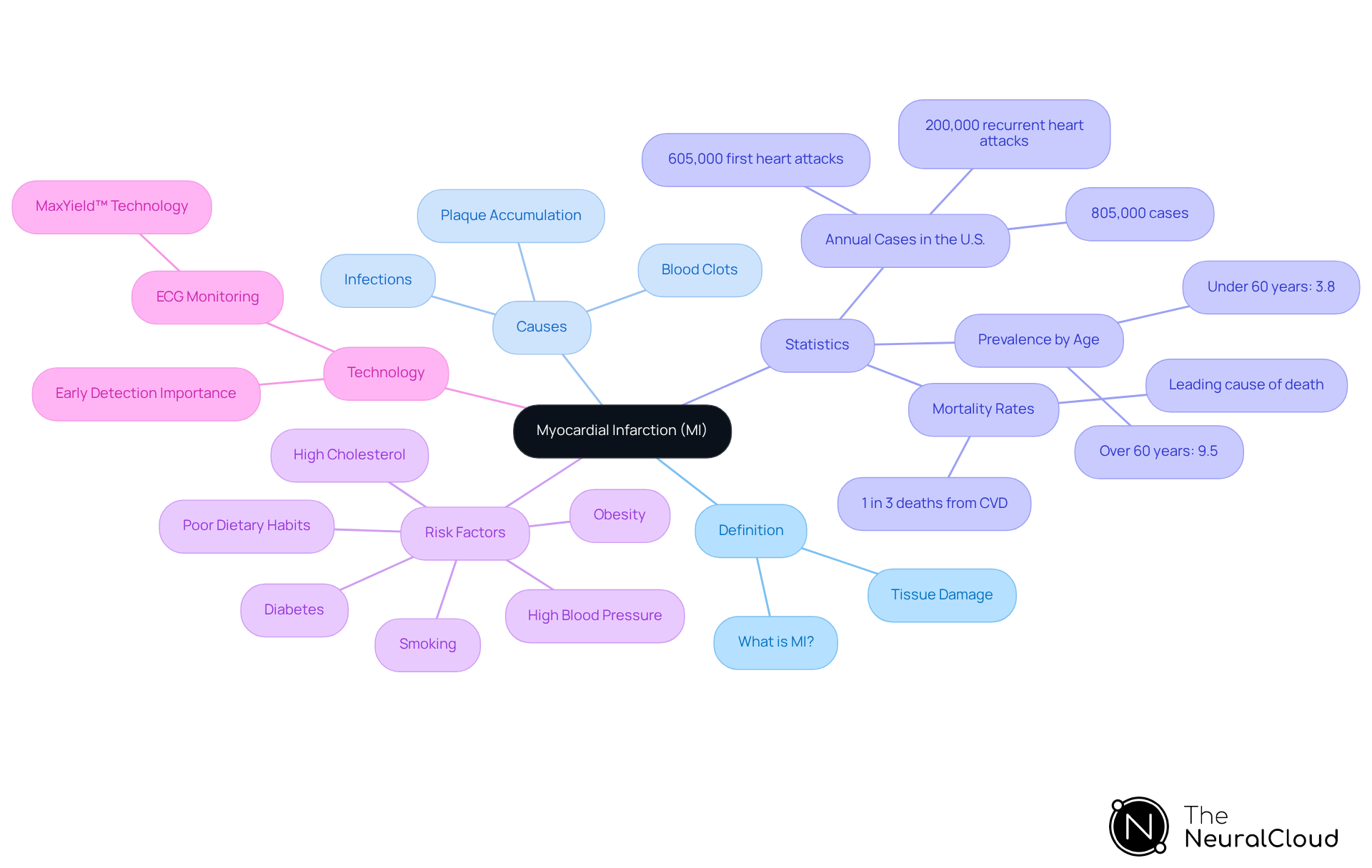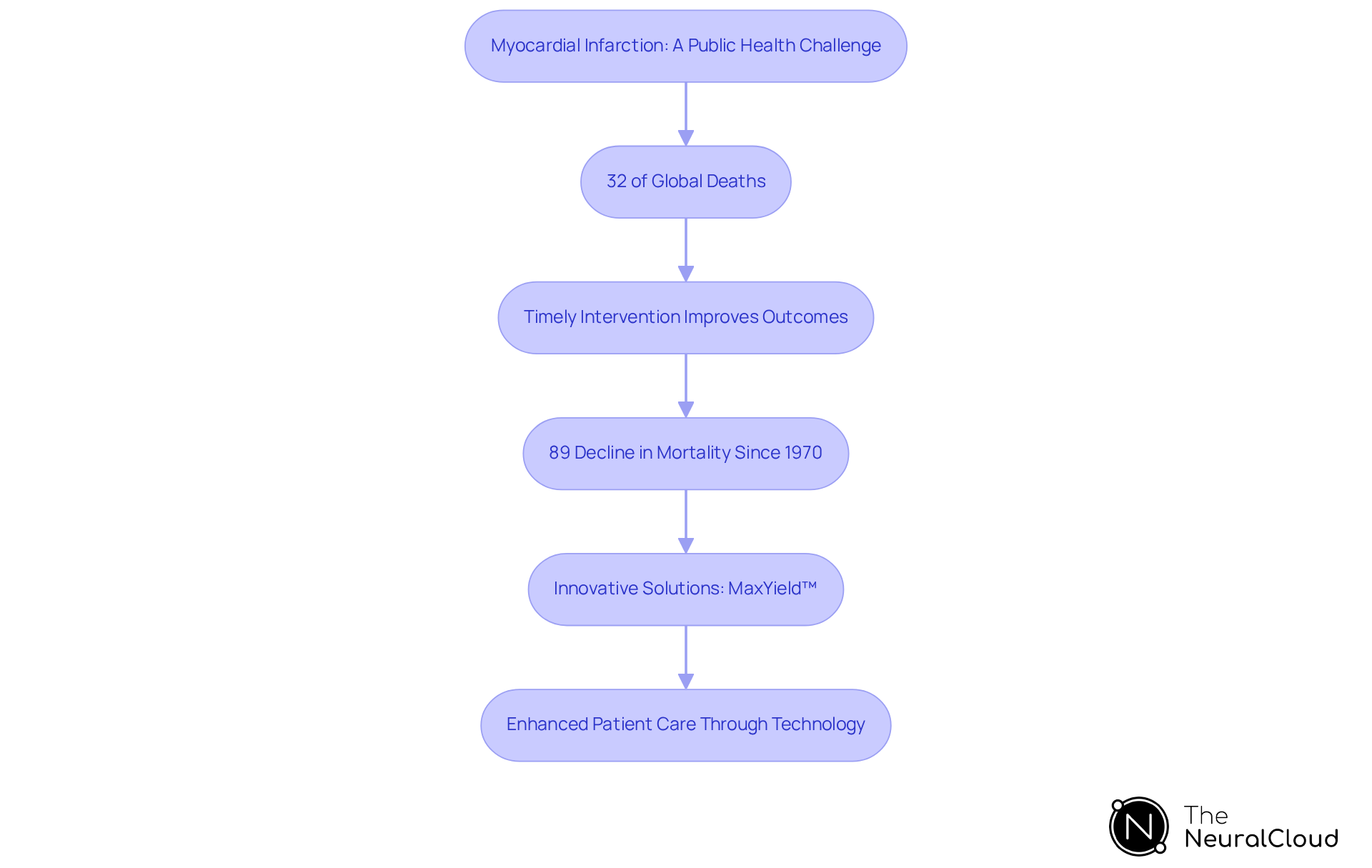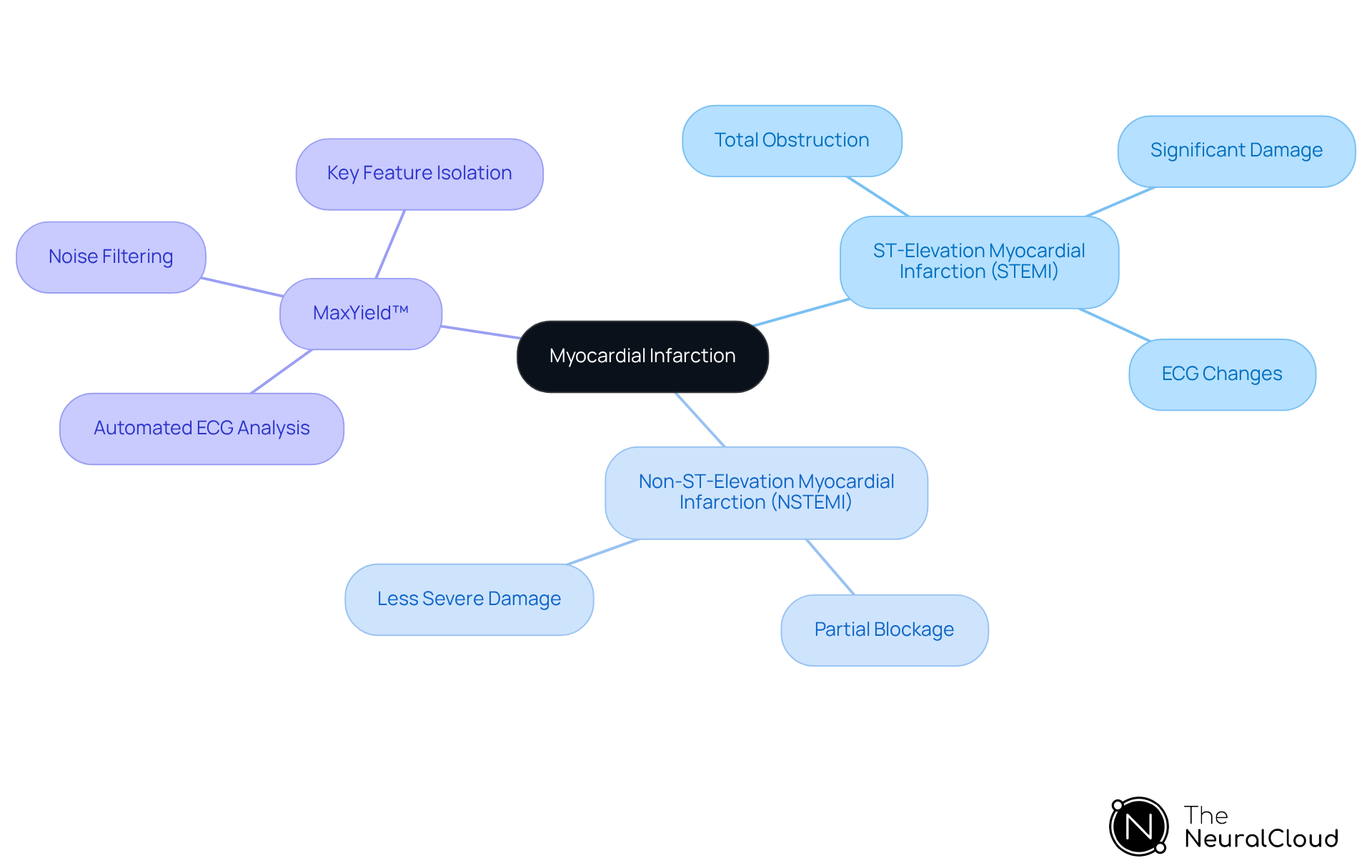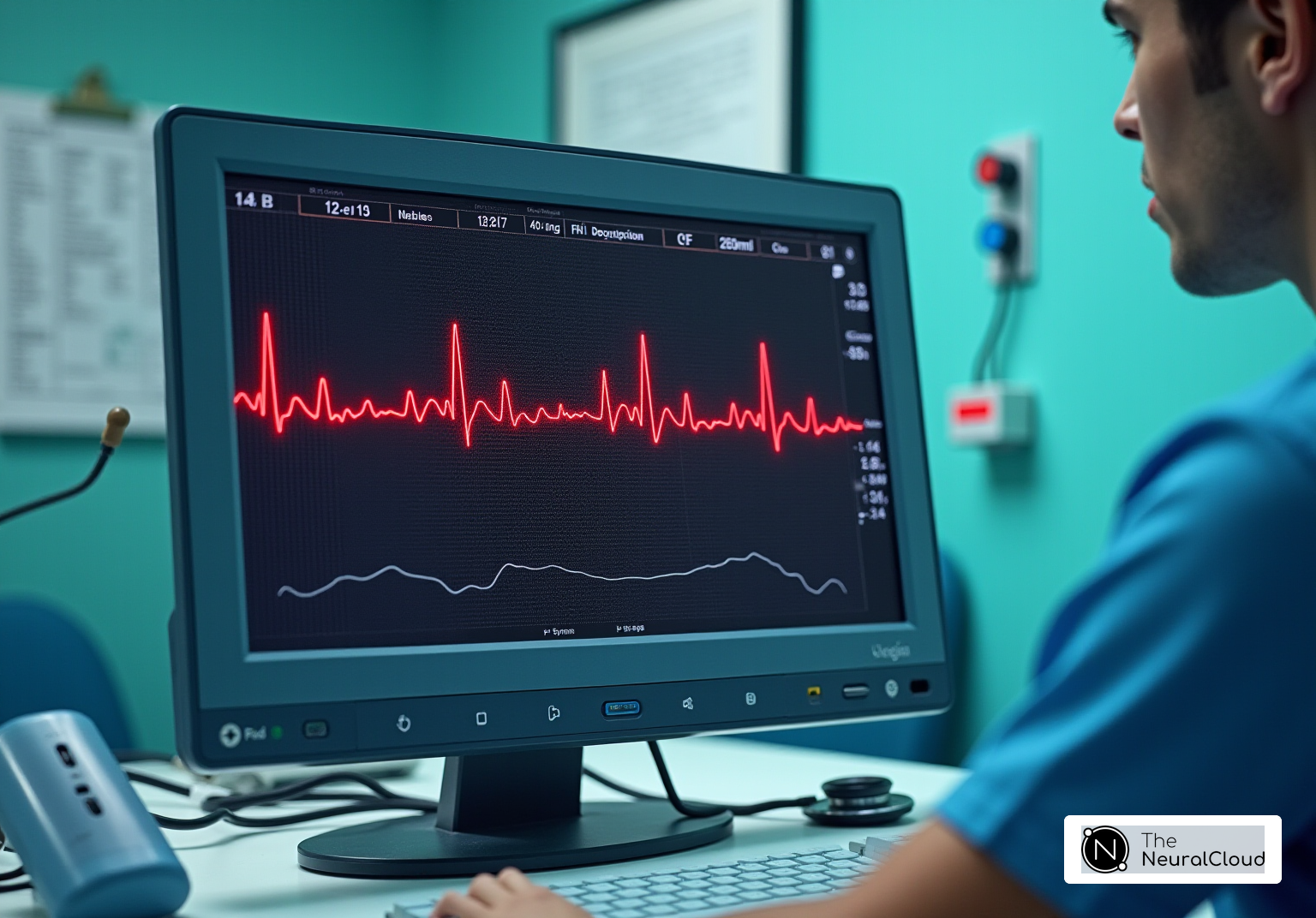Overview
Myocardial Infarction (MI) is characterized by the obstruction of blood flow to a portion of the heart muscle, resulting in tissue damage. This condition is primarily caused by the accumulation of plaque in the coronary arteries. Understanding MI is crucial for effective prevention and management, as it remains a leading cause of morbidity and mortality worldwide.
Advancements in technology, such as Neural Cloud Solutions' MaxYield™, are enhancing early detection and treatment outcomes. The MaxYield™ platform addresses the challenges faced in ECG analysis by providing innovative features that improve accuracy and efficiency. By utilizing advanced algorithms, it enhances the interpretation of ECG data, allowing healthcare professionals to make informed decisions quickly.
The benefits of MaxYield™ include:
- Improved patient outcomes
- Reduced diagnostic errors
- Streamlined workflows
Ultimately, this leads to better healthcare delivery. This platform not only aids in the early detection of MI but also supports ongoing management strategies, ensuring that healthcare providers can respond effectively to patient needs.
Introduction
Myocardial Infarction (MI) is a significant health concern, impacting millions annually and carrying profound implications for public health. Understanding MI extends beyond a mere medical definition; it involves recognizing the pressing necessity for effective prevention and timely intervention to save lives. As the foremost cause of death worldwide, it prompts the inquiry: how can technological advancements and heightened awareness alter the trajectory of this widespread threat? This article examines the complexities of myocardial infarction, detailing its definitions, risk factors, and the innovative solutions that are revolutionizing cardiac care.
Define Myocardial Infarction (MI): Understanding the Medical Term
Myocardial Infarction (MI), commonly known as a cardiac arrest, occurs when blood circulation to a segment of the heart muscle is obstructed, resulting in tissue damage. This blockage is primarily caused by the accumulation of plaque in one or more coronary arteries, which can rupture and form a blood clot. The term 'myocardial' pertains to the heart muscle, while 'infarction' signifies tissue death due to insufficient blood supply. MI represents a major health concern, being the leading cause of illness and death globally, with approximately 805,000 cases reported annually in the United States alone. This statistic underscores the critical need for prompt medical intervention to restore blood flow and mitigate damage to the heart.
Neural Cloud Solutions' innovative MaxYield™ neural network technology significantly enhances the accuracy of ECG monitoring, which is vital for the early detection of heart attacks. Notably, about 1 in 5 cardiac events are silent, indicating that damage can occur without the individual being aware, thereby highlighting the importance of awareness and early identification. The global incidence of heart attacks varies greatly, with studies indicating that the rate among individuals over 60 years old is approximately 9.5%, compared to 3.8% in those younger than 60. This difference emphasizes the heightened risk associated with aging populations, necessitating targeted screening and diagnostic strategies. Furthermore, cardiovascular disease remains the leading cause of death across various racial and ethnic groups in the U.S., with significant disparities in mortality rates; for instance, 22.6% of deaths among Black (Non-Hispanic) individuals were attributed to cardiovascular disease in 2021.
Understanding what does MI mean in medical terms is essential for of myocardial damage. Key risk factors include:
- High blood pressure
- High cholesterol
- Smoking
- Diabetes
- Obesity
- Poor dietary habits
Recent studies have also indicated that infections may trigger MI, suggesting a potential infectious component in its pathogenesis. This evolving understanding of MI's causes and implications highlights the necessity for ongoing advancements in diagnostic and therapeutic strategies. Initiatives such as Million Hearts aim to reduce heart disease risk factors, which may be particularly relevant for health tech developers focused on preventive strategies. The integration of advanced ECG evaluation through Neural Cloud Solutions' MaxYield™ technology, which utilizes a beat-by-beat analysis method to differentiate genuine ECG signals from interference, ensures that healthcare providers can obtain actionable insights, ultimately improving patient outcomes in the context of heart attacks.

Context and Importance of Myocardial Infarction in Healthcare
According to the World Health Organization, myocardial damage, which is referred to as what does MI mean in medical terms, continues to pose a significant public health challenge, accounting for approximately 32% of all global deaths. The urgency of addressing what does MI mean in medical terms is clear, since timely intervention can significantly enhance patient outcomes. For example, the mortality rate from acute myocardial infarction has experienced an impressive decline of 89% from 1970 to 2022, showcasing advancements in medical care and technology. Innovative solutions, such as the MaxYield™ platform from Neural Cloud Solutions, are instrumental in this progress by improving ECG data analysis through advanced noise filtering and wave recognition.
The MaxYield™ platform automates the labeling of P, QRS, and T Wave onsets, offsets, and time-series intervals. This automation allows healthcare professionals to process more data in less time, facilitating rapid diagnosis and treatment, particularly regarding what does MI mean in medical terms. The integration of such cutting-edge tools is essential for managing cardiac emergencies effectively. As noted by Latha Palaniappan, "Thanks to sustained public investment, we’ve seen a remarkable 90% decline in heart attack deaths, a medical miracle made possible by the synergistic power of science, medicine, and public health."
As we approach 2025, focusing on enhancing myocardial outcomes through prompt interventions and advanced technologies like MaxYield™ will be crucial in further reducing mortality rates, particularly in understanding what does MI mean in medical terms. This includes the identification of new digital biomarkers that can aid in . The continuous evolution of tools like MaxYield™ exemplifies the commitment to improving patient care in the face of persistent health challenges.

Key Characteristics and Variations of Myocardial Infarction
Myocardial infarction can be classified into several types based on underlying mechanisms and clinical presentation. The two primary categories are ST-Elevation Myocardial Infarction (STEMI) and Non-ST-Elevation Myocardial Infarction (NSTEMI). STEMI is characterized by a total obstruction of a coronary artery, leading to significant damage to the cardiac muscle, as indicated by specific changes on an ECG. Conversely, NSTEMI involves partial blockage, resulting in less severe damage. Understanding these distinctions is crucial for healthcare providers, as they influence the urgency of treatment and the and minimize heart damage.
The integration of advanced platforms like MaxYield™ enhances diagnostic capabilities in this context. MaxYield™ automates ECG analysis by mapping ECG signals through noise and isolating key features in every heartbeat. This technology improves the accuracy of identifying cardiac events and supports confident clinical decision-making, particularly in urgent situations such as myocardial infarction.
Features of MaxYield™
- Automated ECG Analysis: Streamlines the process of interpreting ECGs.
- Noise Filtering: Enhances signal clarity for accurate diagnostics.
- Key Feature Isolation: Identifies critical characteristics in each heartbeat.
Advantages for Healthcare Professionals
- Improved Accuracy: Reduces the likelihood of misinterpretation in ECG readings.
- Enhanced Decision-Making: Provides reliable data to inform urgent clinical choices.
- Time Efficiency: Saves valuable time in high-pressure situations, allowing for quicker interventions.
In summary, MaxYield™ not only addresses the challenges of ECG analysis but also empowers healthcare professionals with the tools needed to deliver timely and effective care during myocardial infarction.

Conclusion
Myocardial infarction (MI) represents a critical health issue arising from the interruption of blood flow to the heart muscle, resulting in significant tissue damage. Understanding MI is essential not only for medical professionals but also for the general public, as increased awareness can lead to quicker interventions and improved outcomes. This article underscores the importance of recognizing MI's symptoms, risk factors, and the technological advancements that aid in its management.
Key points discussed include alarming statistics surrounding MI, such as its status as a leading cause of death globally and the often silent nature of many cardiac events. The article emphasizes the role of innovative technologies, particularly Neural Cloud Solutions' MaxYield™ platform, which enhances ECG monitoring and diagnostic accuracy. Additionally, it outlines the differences between STEMI and NSTEMI, underscoring the urgency of appropriate treatment based on the type of myocardial infarction.
In light of the persistent challenges posed by myocardial infarction, it is crucial to prioritize education, prevention, and early detection strategies. The integration of advanced diagnostic tools not only improves patient outcomes but also exemplifies the ongoing commitment to combating cardiovascular diseases. By fostering awareness and understanding of MI, individuals and healthcare systems can collaborate effectively to reduce the incidence and impact of this serious condition.
Frequently Asked Questions
What is Myocardial Infarction (MI)?
Myocardial Infarction (MI), commonly known as a cardiac arrest, occurs when blood circulation to a segment of the heart muscle is obstructed, leading to tissue damage.
What causes Myocardial Infarction?
MI is primarily caused by the accumulation of plaque in one or more coronary arteries, which can rupture and form a blood clot, obstructing blood flow to the heart.
Why is Myocardial Infarction a significant health concern?
MI is a major health concern as it is the leading cause of illness and death globally, with approximately 805,000 cases reported annually in the United States alone.
How does aging affect the risk of Myocardial Infarction?
The risk of MI increases with age; studies show that the incidence among individuals over 60 years old is approximately 9.5%, compared to 3.8% in those younger than 60.
What are the key risk factors for Myocardial Infarction?
Key risk factors include high blood pressure, high cholesterol, smoking, diabetes, obesity, and poor dietary habits.
What is the significance of silent cardiac events in relation to Myocardial Infarction?
About 1 in 5 cardiac events are silent, meaning damage can occur without the individual being aware, highlighting the importance of awareness and early identification for effective intervention.
How does Neural Cloud Solutions' MaxYield™ technology contribute to the detection of Myocardial Infarction?
MaxYield™ technology enhances the accuracy of ECG monitoring, which is vital for the early detection of heart attacks by providing actionable insights through advanced analysis of ECG signals.
What disparities exist in cardiovascular disease mortality rates?
Cardiovascular disease remains the leading cause of death across various racial and ethnic groups in the U.S., with significant disparities; for example, 22.6% of deaths among Black (Non-Hispanic) individuals were attributed to cardiovascular disease in 2021.
Are there any recent findings regarding infections and Myocardial Infarction?
Recent studies have indicated that infections may trigger MI, suggesting a potential infectious component in its pathogenesis, which underscores the need for ongoing research in this area.
What initiatives aim to reduce the risk factors associated with heart disease?
Initiatives such as Million Hearts aim to reduce heart disease risk factors, which are particularly relevant for health tech developers focused on preventive strategies.






